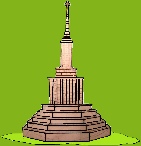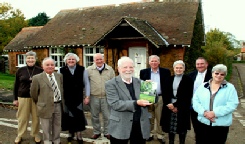
 Local Business, Food, Accommodation
History Group
Local Events
Local Business, Food, Accommodation
History Group
Local Events




 Summary of Castle Rising
Summary of Castle Rising
















A BRIEF HISTORY OF THE PARISH
The village of Castle Rising is unusual in two respects. Firstly, it has not grown in size since its Saxon origins, and secondly, it has a historical importance much larger than its small size would suggest. It has connections with Kings and Queens, Prime Ministers, Archbishops and Saints, and has in small ways influenced the course of English history.
Although there are some signs of Roman and earlier inhabitants in the area, the first the indications of a village structure as we know it today was during the Saxon period (6th-
After the conquest, William the Conqueror gave the parish first to his half-
After Isabella’s death in 1358, the Manor was used mainly as a Royal Chase for deer hunting and falconry. A herd of fallow deer was kept in a deer park, whose boundary can still be traced. Edward III and the Black Prince, Isabella’s son and grandson respectively were occasional visitors to the parish, probably also availing themselves of the sport which the Chase provided while visiting her. However, over time the village and castle became increasingly ignored by its royal owners and in 1544 they were exchanged by Henry VIII with Thomas Howard, 3rd duke of Norfolk, for land elsewhere. The Dukes of Norfolk, members of the most powerful family in England at the time and already members of the House of Lords, were keen to increase their political influence in the House of Commons. In 1558, during the last year of Queen Mary’s reign, the 4th Duke utilising the Borough status of Castle Rising arranged for the Borough to send its first two MPs to the House of Commons. Castle Rising continued to send two MPs to parliament until it was disenfranchised in 1832.
The 4th Duke was later executed by Queen Elizabeth for his part in the religious wars of the time. After his death there were a series of Lords of the Manor, including Edward de Vere, who some think was the “real” author of Shakespeare’s works and Philip Howard who was also executed, though later canonized by the Pope. The Manor of Castle Rising reverted to the Crown on Philip’s execution, but after James I came to the throne, it was returned to the Dukes of Norfolk, and Henry Howard, brother of the 4th Duke, built the beautiful Jacobean Hospital which still stands in the village.
The borough remained in the ownership of the Dukes of Norfolk until 1692, but in the latter part of that period two other families, prominent in English society at the time were also showing an interest in the village. Robert Walpole, from nearby Houghton, and Sir Robert Howard, an eminent playwright and brother-
The rivalry between the Howards and the Walpoles had a considerable effect on Castle Rising for much of the 18th century. Although the Walpoles owned fewer properties in the village than the Howards they lived physically closer (Houghton rather than Ashtead in Surrey), and it was decided between them that each should nominate one of the two Castle Rising MPs at each election. Usually these were close relatives of the families. The Mayors of Castle Rising also participated in the election process so they too were nominated by the two families with each nominee serving in alternate years. So much for local democracy! John Wakefield, a Walpole appointee, was Mayor of Castle Rising 27 times between 1745 and 1797. He and his wife built the imposing house, now 9 Lynn Road, at the west end of the village and both are buried in the village churchyard. As time went by, the rivalry between the Howards and the Walpoles lessened and may have served the village well. Parliamentary elections, held roughly every four years, were often a time when no expenses were spared in the village as dignitaries from the two families came for the elections. Many of the vernacular buildings in the village were built or renovated during the 18th and 19th centuries, and it appears to have been a time of stability. Since medieval times, access to King’s Lynn had been via a road that skirted the old deer park and went through Gaywood (perhaps even prior to the establishment of Lynn). In 1770 this road was made into a Turnpike Road between Lynn and Dersingham, considerably improving access to the outside world. Milestone number 4 was at the west entrance to the village, but has since disappeared.
With the passing of the Great Reform Act in 1832, Castle Rising lost its right to elect two MPs and thus its political significance. It became administratively part of the Rural district of Freebridge Lynn, and later part of the Borough of King,s Lynn and West Norfolk. In 1895 as a result of the Local Government Act, Castle Rising elected its first Parish Council which continues to the present time.
The ownership of the Manor remained with different branches of the Howard family, but until the most recent branch of the family, they mostly had several more wealthy estates elsewhere and visited Castle Rising infrequently. The estate was managed through agents and the correspondence between agents and owners has been preserved in the Norfolk Record Office giving a fascinating glimpse of village life until the end of the 19th Century. The village at this time had four farms, two mills and an active sand-
In the mid-
By the end of the 19th century, the Manor had been transferred to yet another branch of the Howard family, Mary having died in 1877 with no close heirs. Greville Theophilus, great-
The twentieth century saw great changes in Castle Rising which moved from being a traditional largely self sufficient agricultural village with three working farms, a blacksmith, builder, carpenter, shoemaker and miller, and where most cottagers cultivated their vegetable gardens and allotments as well as keeping livestock such as chickens, pigs, cows and perhaps a pony. Animals grazed on the commons and marshes and children joined in with haymaking and gleaning. The social life of the village, largely centred on the church, was active with weekly dances, women’s clubs and a youth club. The Mansion House was leased by Lord Farquhar as a shooting lodge and the school was busy teaching the children from the large families of that time.
With two World Wars and an intervening depression, the first half of the twentieth century was a difficult time for the nation. The developments of technology in farming, especially in the increased use of machinery saw a reduction in both horses and men employed on the land and in time, the closure of the farms themselves. There was little alternative employment in the village and the estate suffered from reduced rental from its land and properties as well as from death duties. Jobs were to be found in the towns, and life in the village -
Fortunately the later years of the century saw many changes for the better which reversed the status of rural living. Piped water, gas and a sewerage system were provided for the village. Increased car ownership enabled people working elsewhere to live in the country and reduced the need for daily shopping which was once the norm. Two new estates totalling over thirty private houses were built and were probably the greatest contributors to the revival of the village. Improved means of heating, damp-